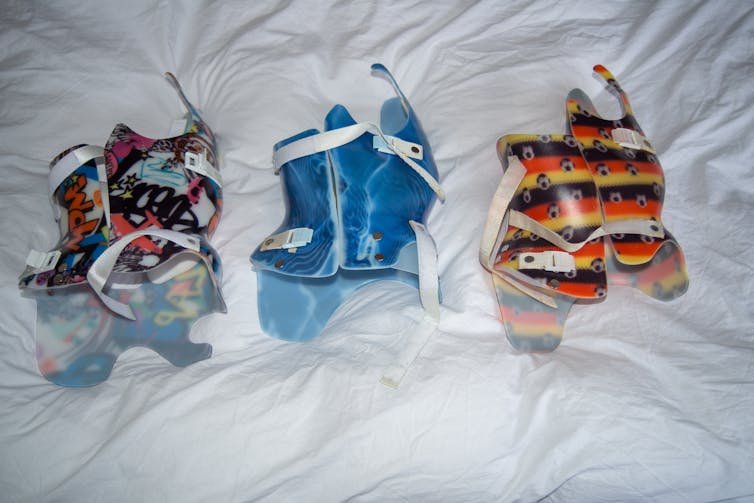The Disney+ series Shardlake is a mystery drama following the journey of Matthew Shardlake (Arthur Hughes), a barrister navigating Tudor England during the reign of Henry VIII. Shardlake’s character has scoliosis, a condition characterised by an irregular sideways twist of the spine, resulting in a visibly curved back with misaligned hips and shoulders.
Set against the backdrop of 16th-century England, Shardlake’s story unfolds in an era long pre-dating X-rays, which let us view the structure of the spine. Consequently, the understanding and treatment of conditions like scoliosis were rudimentary at best.
Historical remedies ranged from stretching, pulling and twisting the spine – and even being stepped on. Surgery was not attempted until 1865, when Jules René Guérin, a French surgeon, attempted to reduce spinal curvature by cutting tendons in the spine. The outcome for the patients was dire.
Thankfully, the trajectory of medical advancement has propelled us far beyond such antiquated practices. The emergence of X-rays and other imaging technology, such as magnetic resonance imaging (MRI), has revolutionised our ability to visualise the structural intricacies of spinal deformities such as scoliosis.
Our understanding of how biological processes govern tissue function and structure, and in turn how the activity of genes regulate these processes, is now paving the way for the development of new treatments aimed at mitigating or even preventing the progression of scoliosis.
Current understanding of the condition has revealed distinct subtypes based on the age of onset and the likely underlying cause.
Among these variants, congenital scoliosis is a rare form of scoliosis, affecting about one in 10,000 newborns, while neuromuscular scoliosis emerges in childhood due to abnormal muscular and nerve activity in the spine.
However, by far the most common form of scoliosis is adolescent idiopathic scoliosis (AIS). As the name implies, it develops in children with onset between ages ten and 18. “Idiopathic” refers to the fact that the cause is not yet known.
It is more common in girls than boys, which together with onset during puberty suggests that hormones may play a part.
Treatment options for children with AIS who are still growing include the use of braces – effectively, a stiff jacket.
A brace exerts corrective pressure on the outer curve of the spine to encourage gradual realignment. For children with severe spinal curvatures, though, surgery may be needed. This involves implanting metal rods, which are attached to the spine with screws, to stop further curvature.

In attempting to understand the cause of AIS, perhaps the biggest debate in the research field is whether spinal curvature is a consequence of changes to muscles and posture, or whether it is due to abnormalities in the spinal bone tissue itself.
To identify these abnormalities in the spinal bone tissue, we need to compare the AIS spinal tissue to the spinal bone tissue of children without the condition (known as the “control group” or just “controls”). Ideally, the control spinal tissue should be from children of the same age without AIS – otherwise, we won’t know for sure whether differences are because of changes in the age of the spine, or whether it is due to AIS.
However, unless there is a surgical requirement to operate, it would be unethical to collect normal spinal tissue from healthy children. Therefore, most research has examined blood samples to identify potential causative factors, such as the hormones oestrogen and melatonin. But these studies have proven inconclusive.
New era of scoliosis treatment on the horizon
Research we have conducted at the University of Birmingham, in collaboration with the Royal Orthopaedic Hospital, involved AIS patients who were undergoing metal rod implant surgery to prevent further curvature of the spine. In this surgical procedure, the metal rods are secured with screws at multiple points along the length of the spine.
Critically, this enabled us to collect displaced spinal bone tissue from the peak of the curve and also from regions of normal, non-curved spine from the same patient. In other words, the patients acted as their own controls.
Genetic analysis of the spinal bone cells, known as “osteoblasts”, identified differences in the activity of genes that regulate bone formation and bone structure between osteoblasts from the peak of the curve and those from non-curved spine. Also, osteoblasts from the peak of the curve were metabolically more active, fuelled with the capacity to grow at a faster rate than those isolated from non-curved spinal bone tissue.
Our findings support the notion that AIS may be driven by changes in the spinal bone tissue itself, regulated by the abnormal activity of genes that control the function of the spinal bone osteoblast cells.
Such studies suggest we are on the cusp of a new era of scoliosis management. An era where we have identified the causative factors that predict which patients will have rapidly progressive curves, and developed new treatments that can reduce the requirement for bracing or surgery. An era, perhaps, where people with scoliosis like Shardlake will simply be prescribed daily tablets to pre-empt the onset of an irregular twisted spine.

